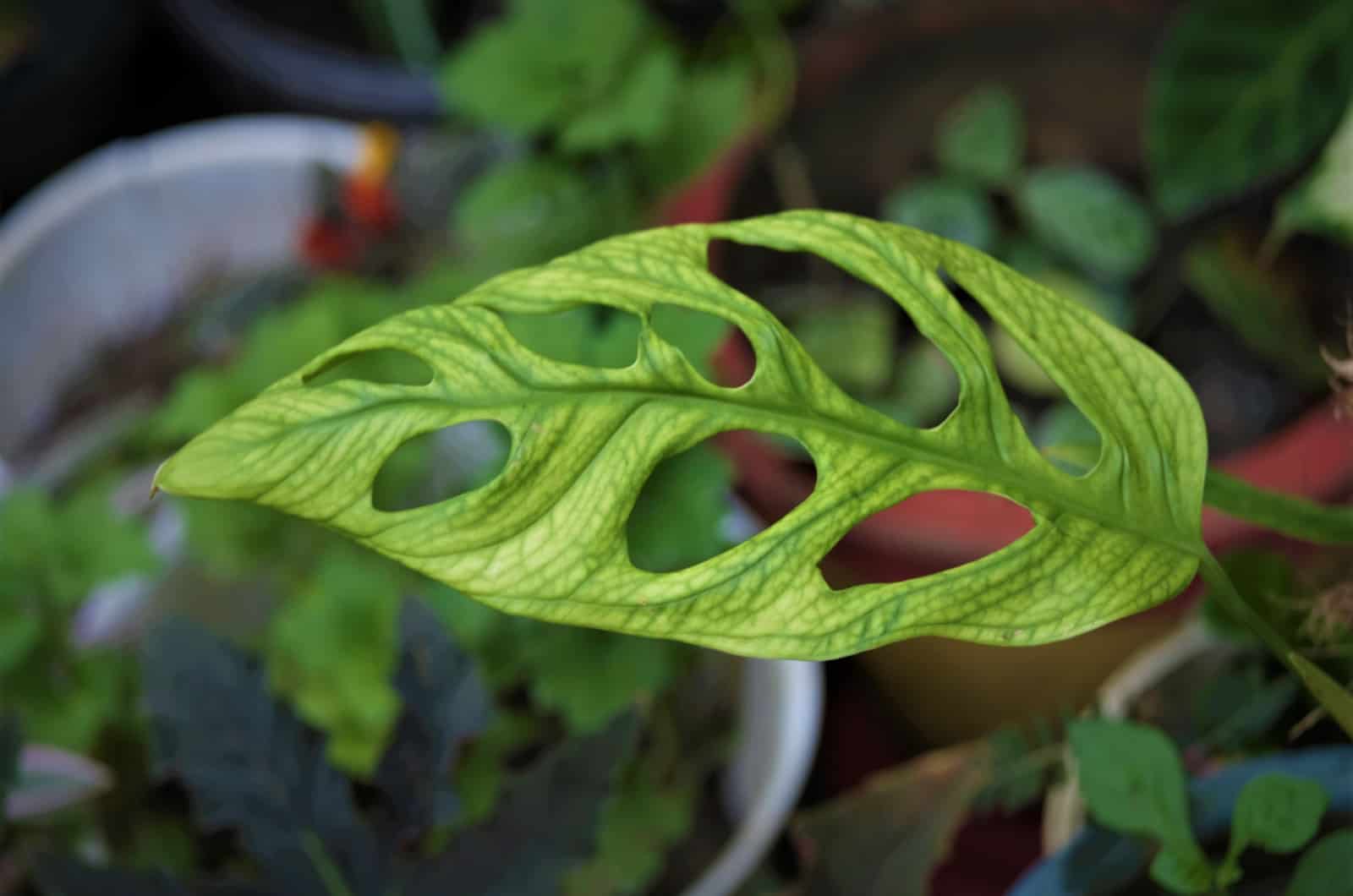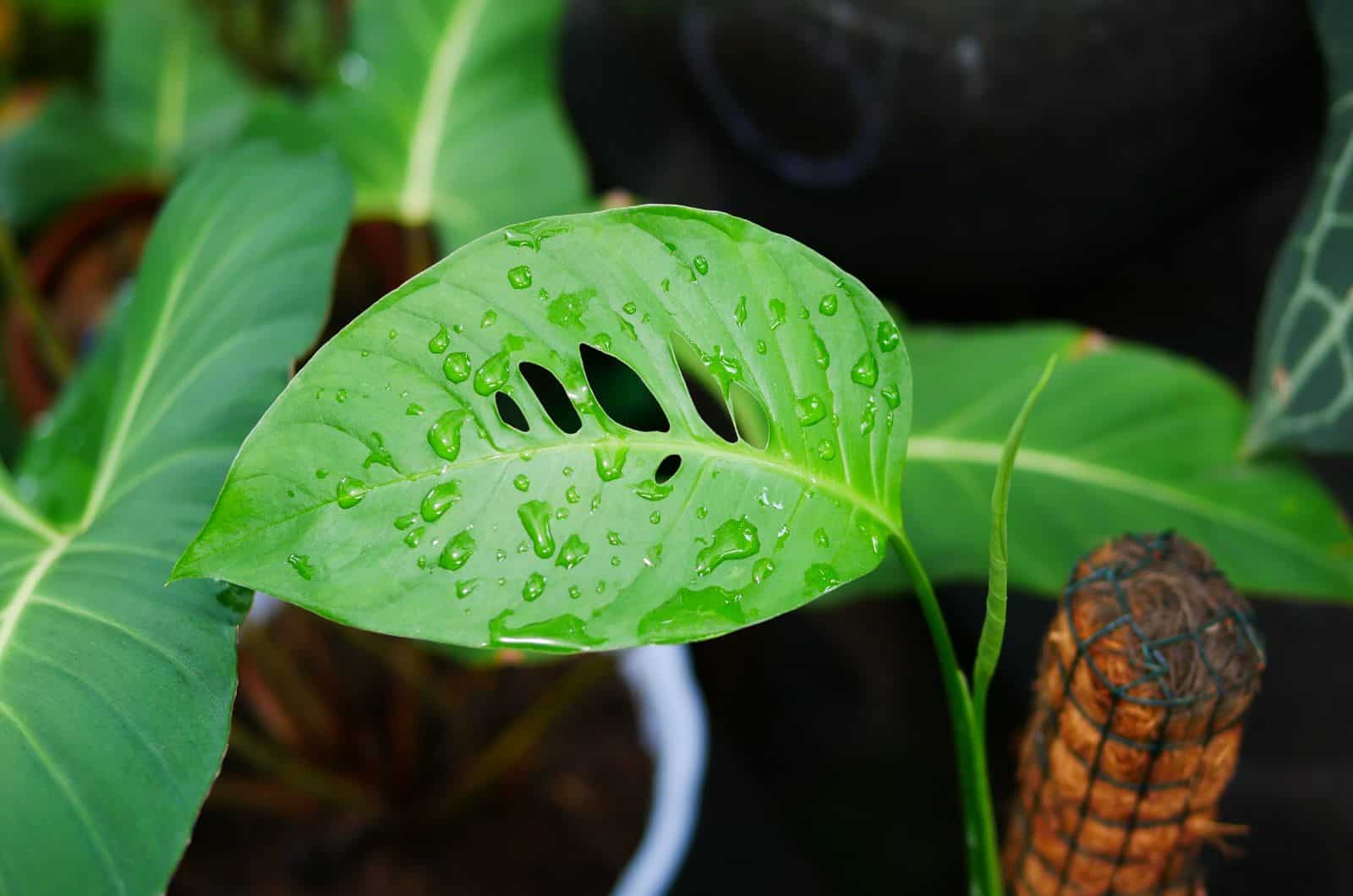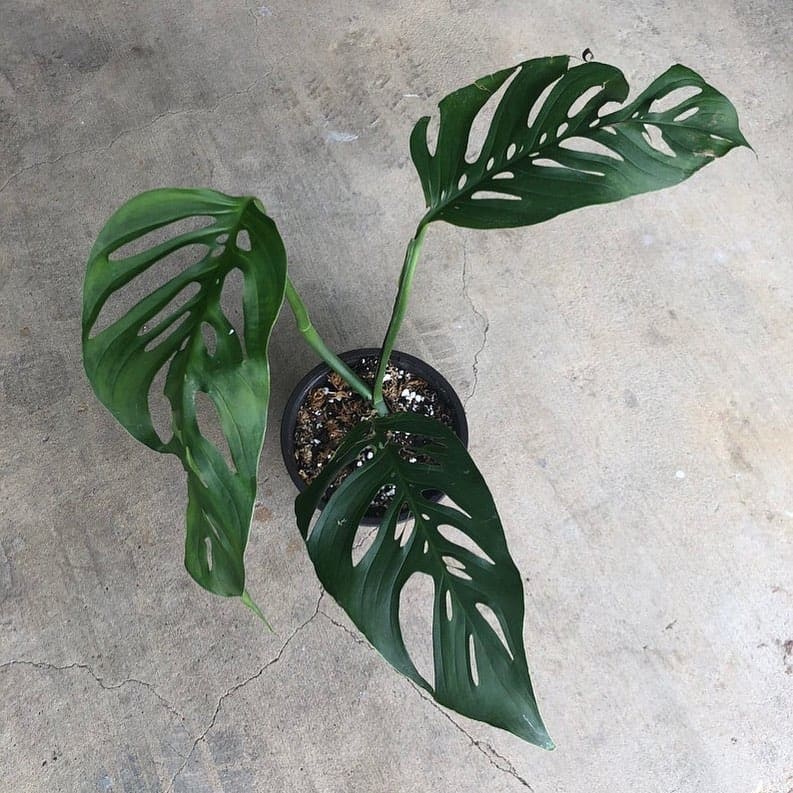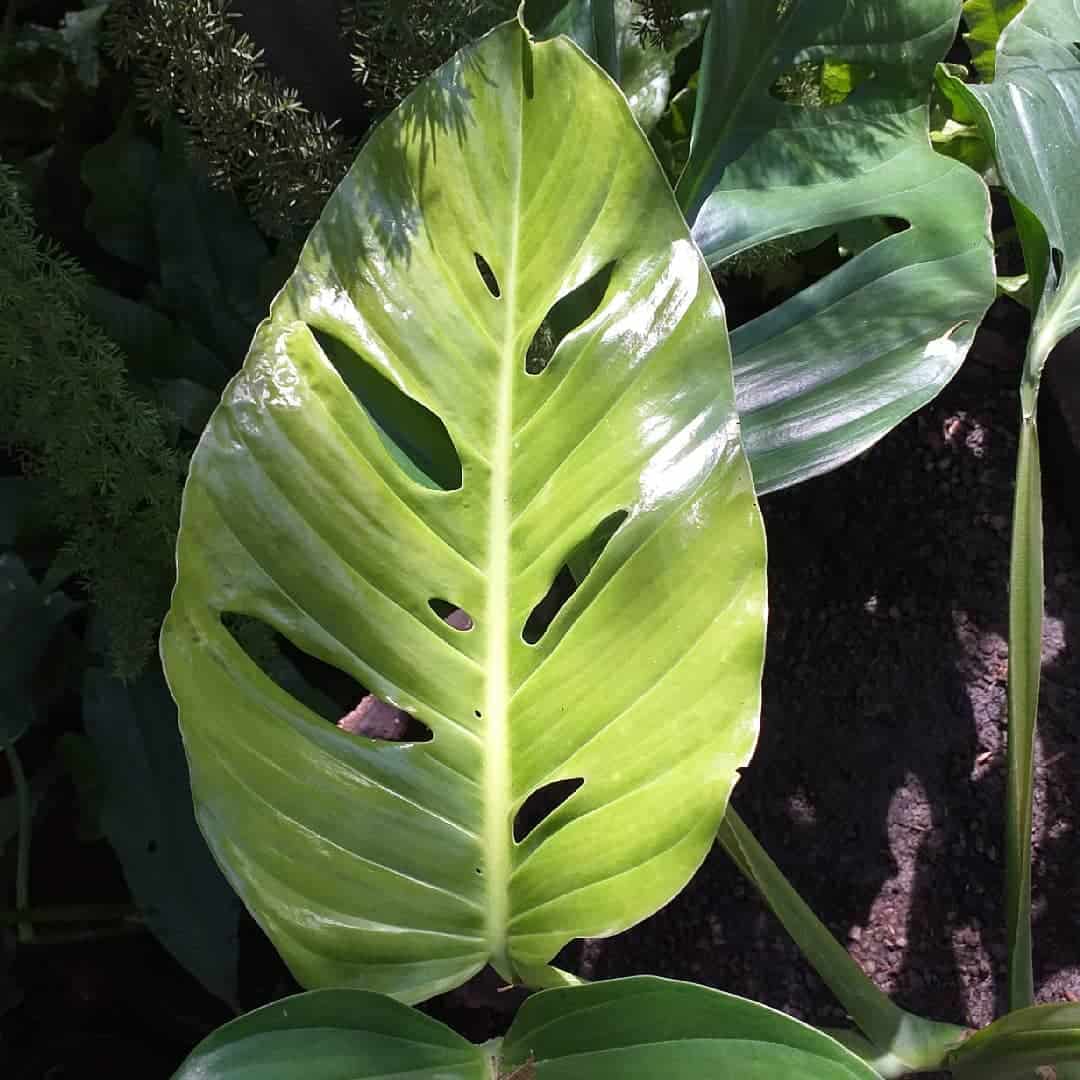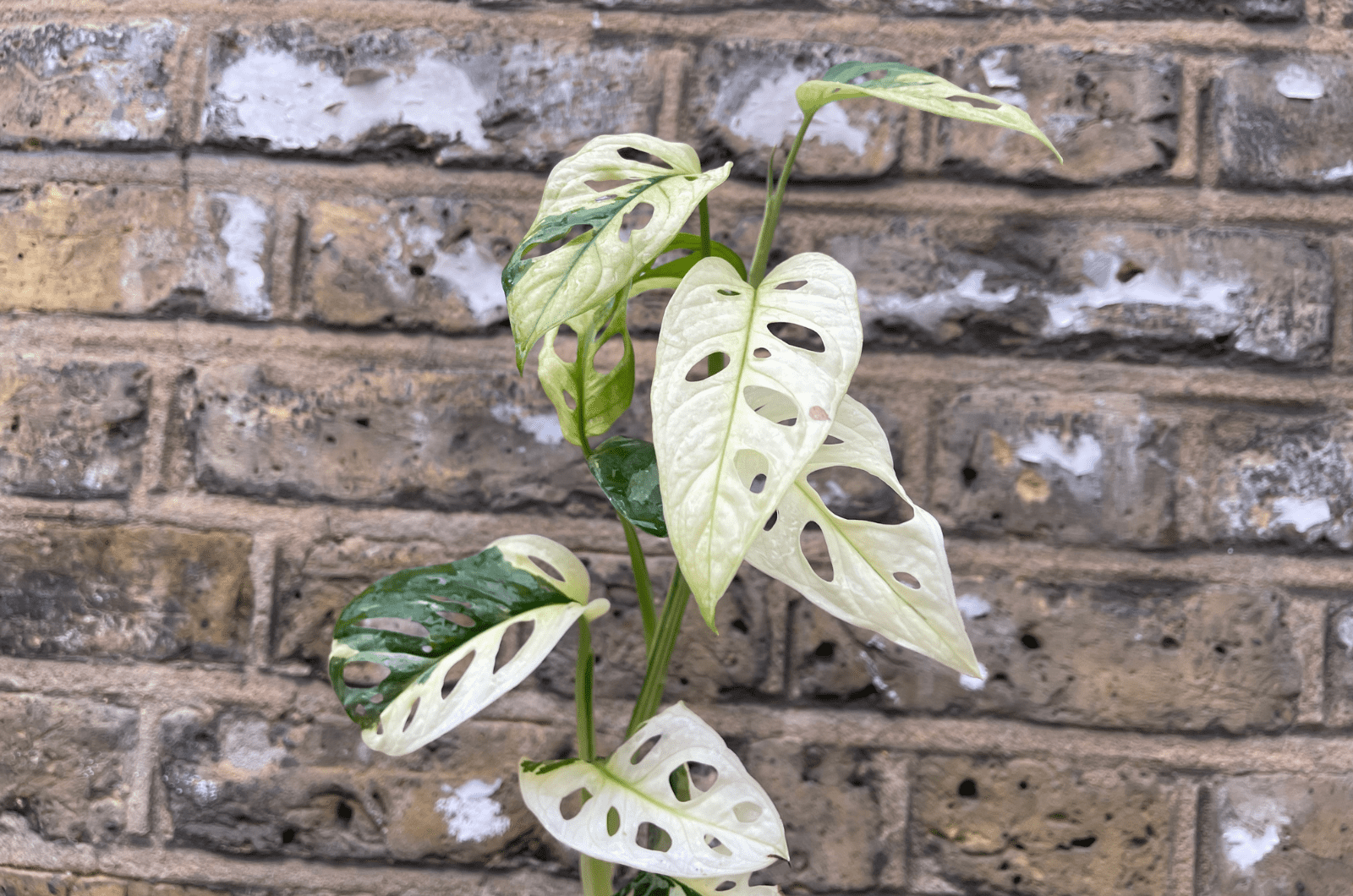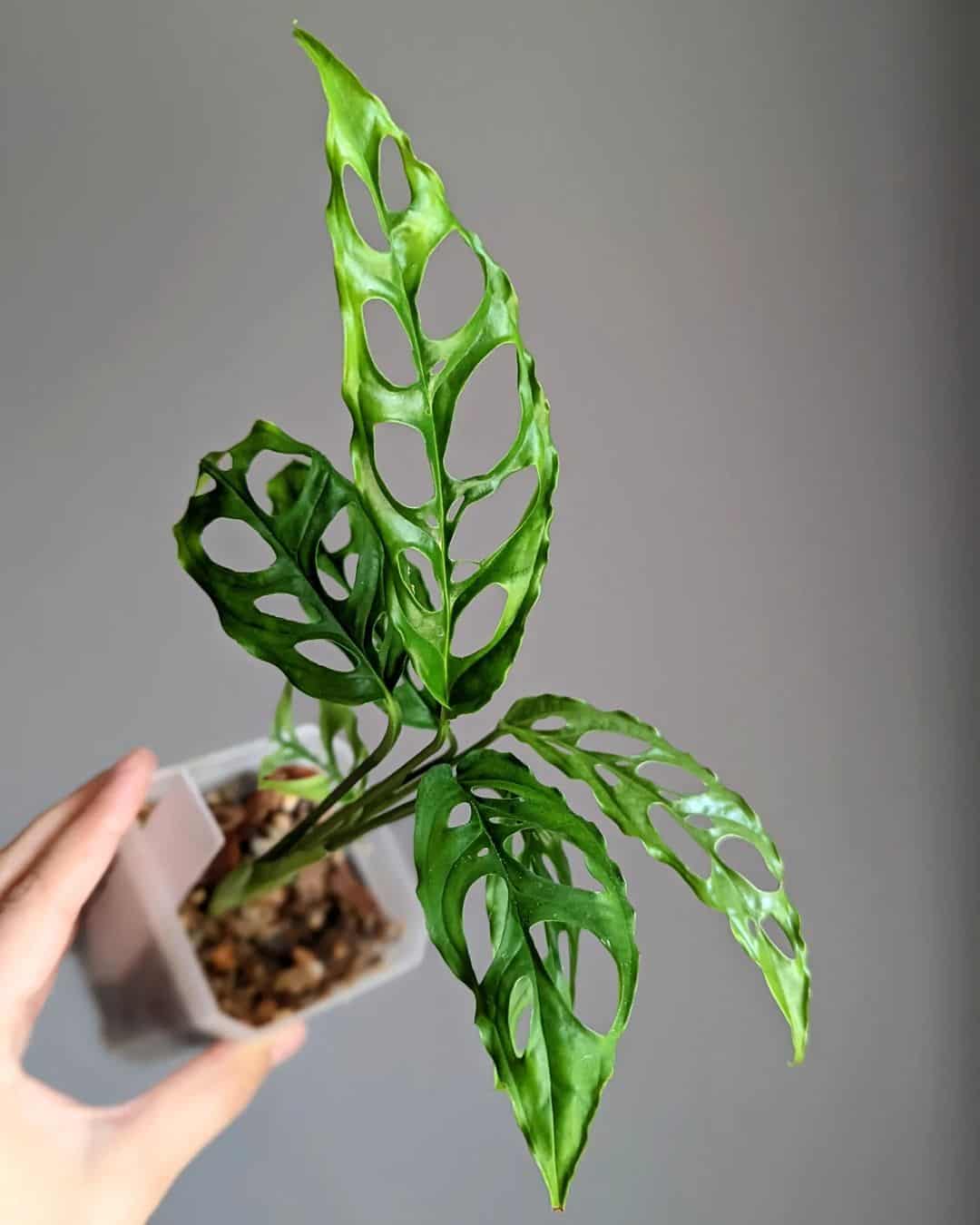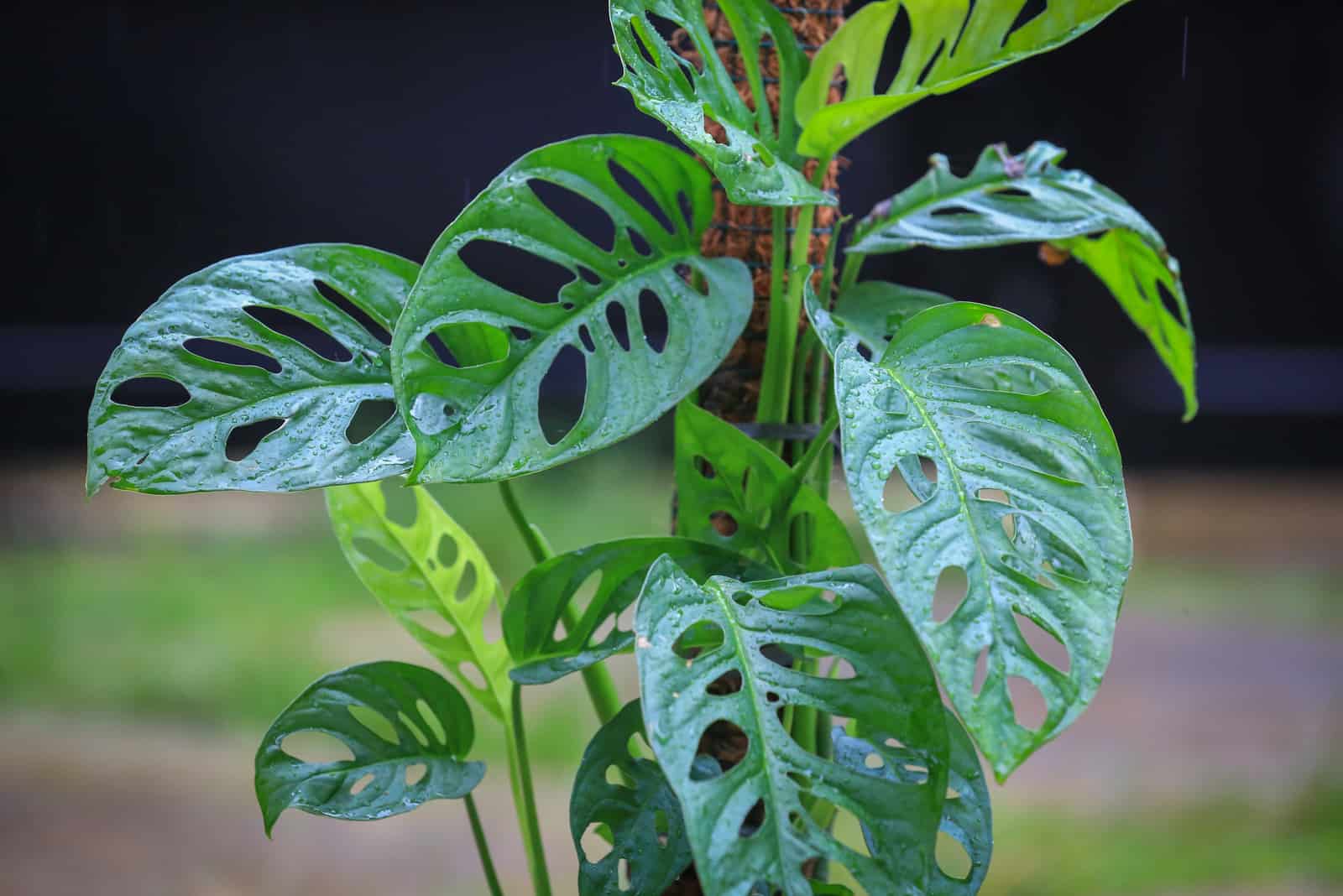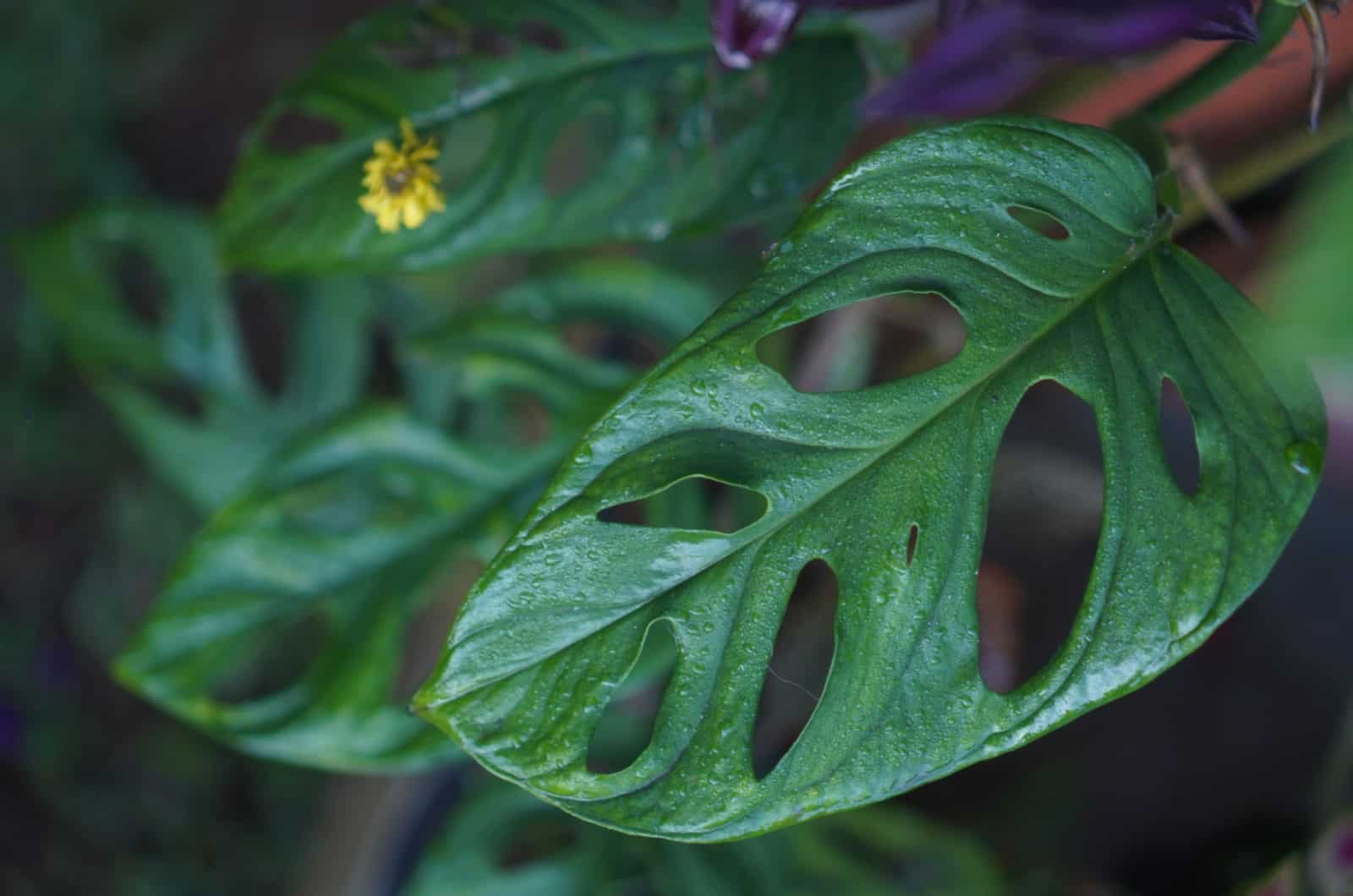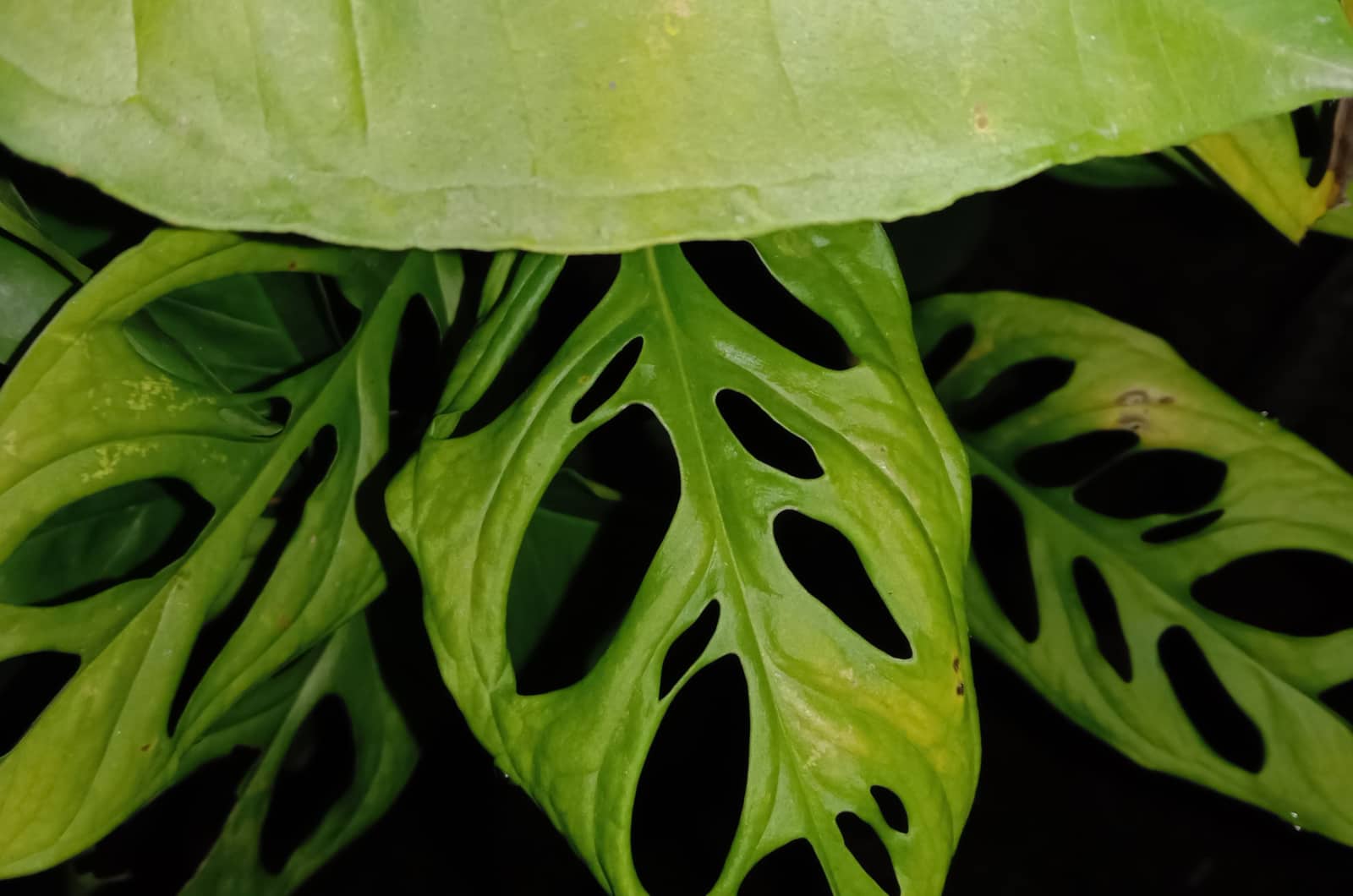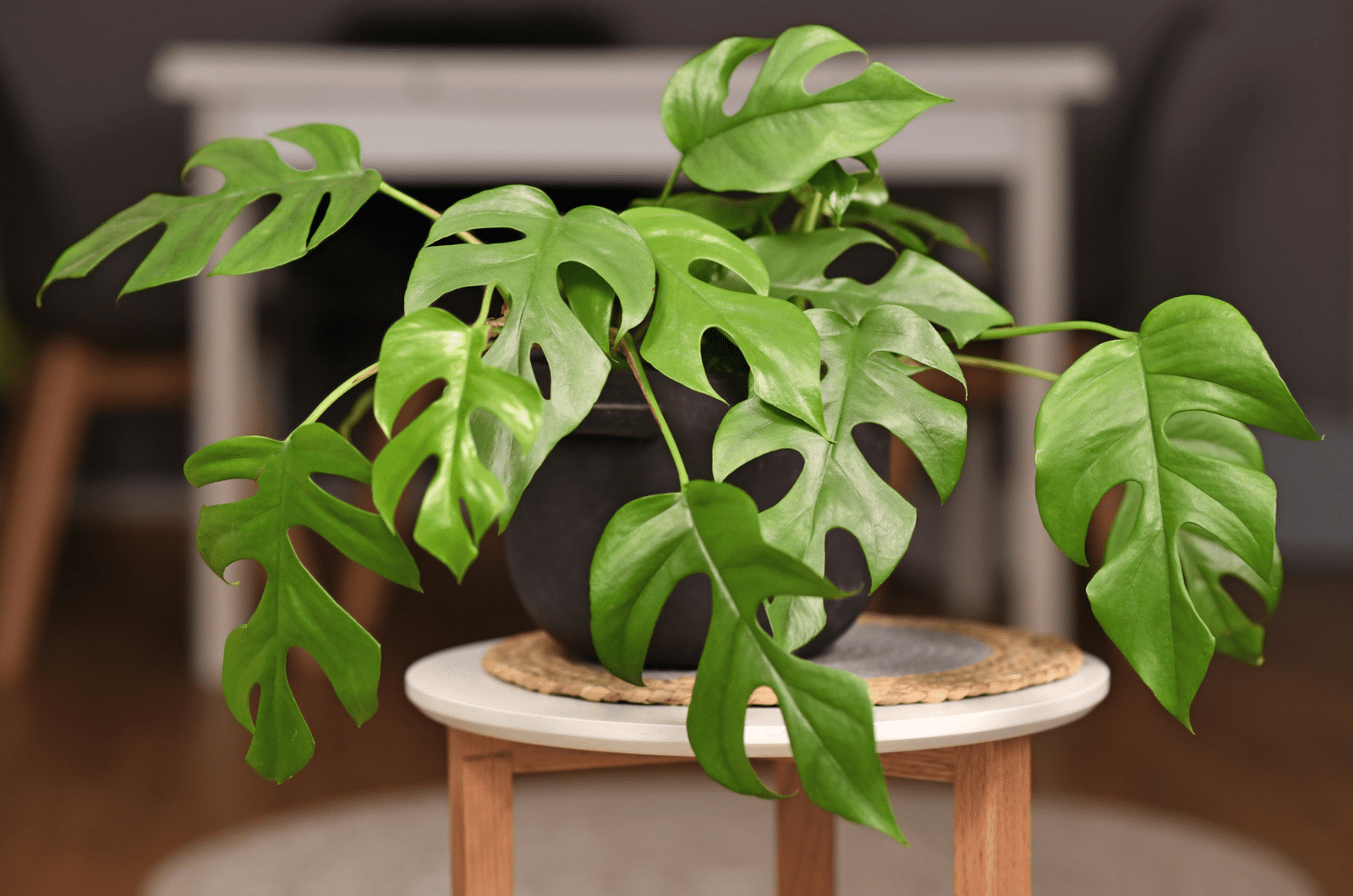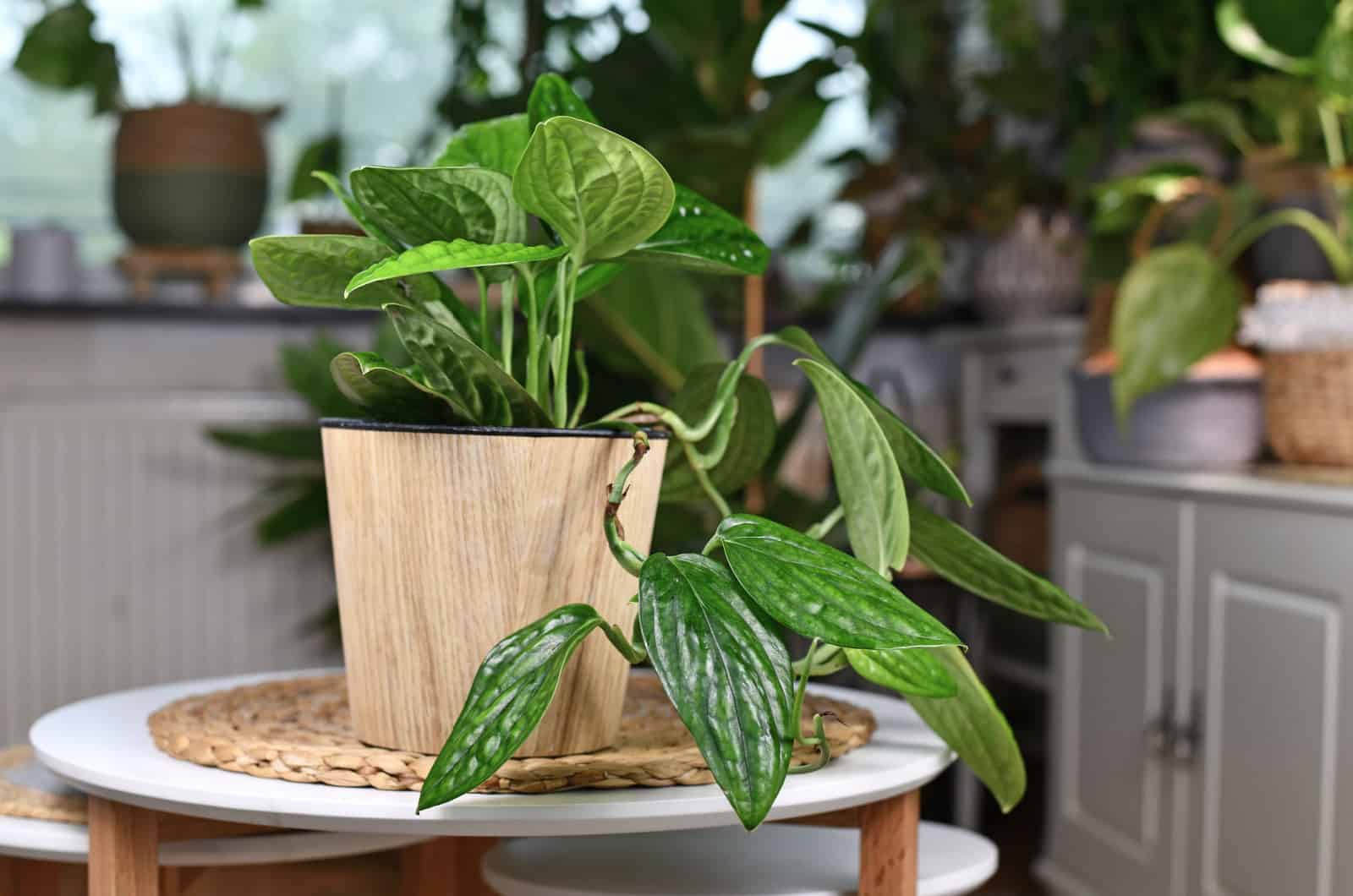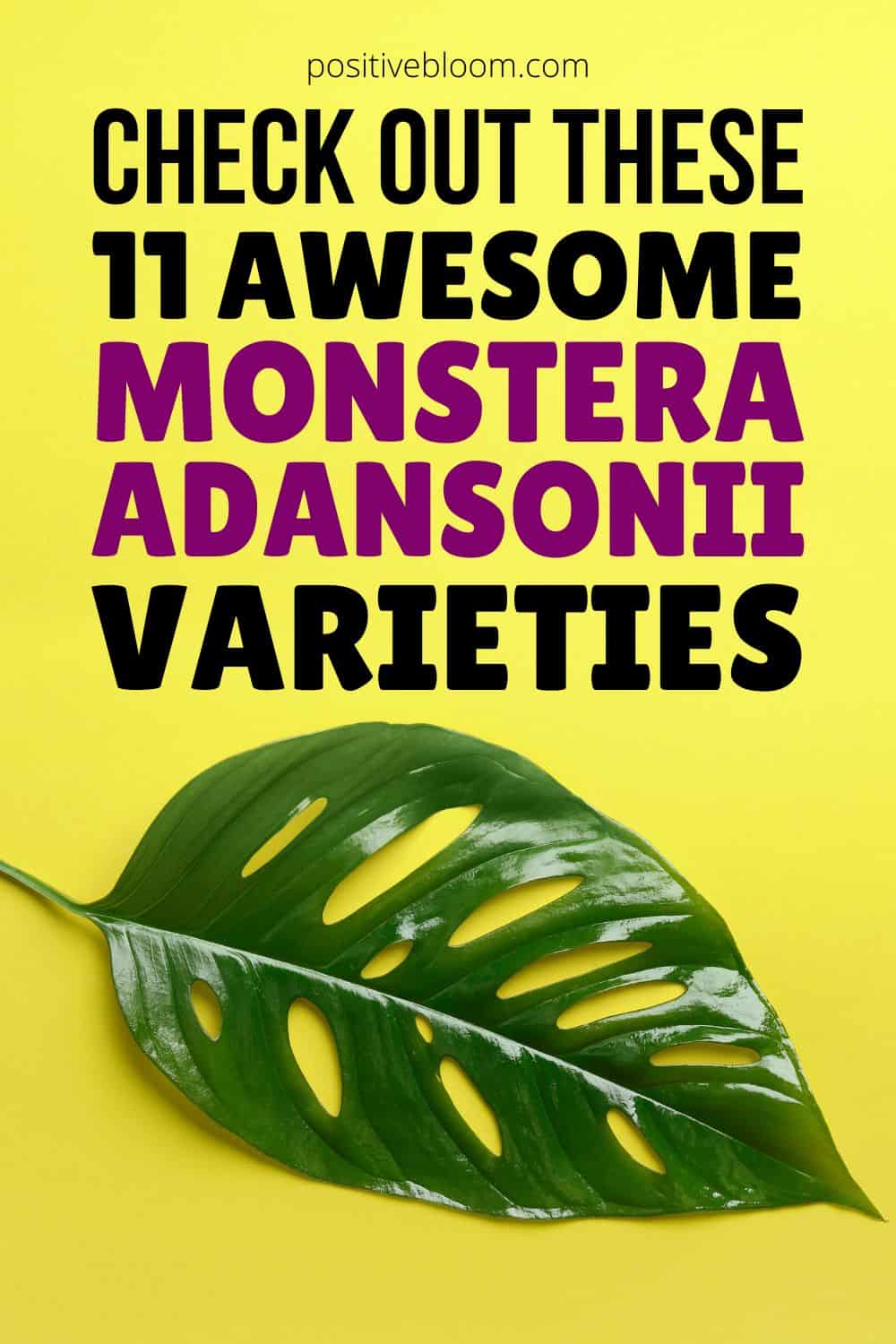Monsteras are one of the most popular houseplants in the world nowadays! With their beautiful, deep-green foliage and fenestrations, they truly make a great addition to any home decor!
There are about 50 different Monstera species, with Monstera Adansonii being the most commonly cultivated Monstera variety. Did you know that there are actually different Adansonii varieties out there?
Well, even though they slightly differ from each other, there are about 9 Monstera Adansonii varieties that would make a great Monstera plant collection!
Monstera plants are truly unique, not only because of their looks, but also because they don’t have any special requirements. This makes it quite easy to take care of them, which is why they are beginner-friendly houseplants.
If you are planning to start collecting Monstera plants, make sure to check out this list of Monstera Adansonii varieties!
Monstera Adansonii Varieties
Botanists often differentiate Monstera Adansonii varieties based on whether they have a round or narrow form, as well as if they’re variegated.
There are five Monstera Adansonii subspecies, which include:
• Monstera Adansonii Friedrichsthalii
• Monstera Adansonii Laniata
• Monstera Adansonii Blanchetii
• Monstera Adansonii Klotzschiana
• Monstera Adansonii Archipelago
However, the majority of people also include several other Monstera varieties due to their remarkable resemblance to the Monstera Adansonii varieties. These include:
• Monstera Obliqua
• Monstera Acuminata
• Monstera Lechleriana
• Monstera Punctulata
• Monstera Epipremnoides
• Rhaphidophora Tetrasperma or “Mini Monstera”
We will cover all the types of Monstera adansonii, so keep on reading to see which variety suits you the best!
1. Monstera Adansonii Friedrichsthalii
The gorgeous Monstera friedrichsthalii, sometimes called Monstera adansonii, is one of the loveliest Monstera species. However, those aren’t the only names for this type – many gardeners also call it a Swiss cheese plant or vine, a monkey mask, or a plant with five holes.
Because it produces oval-shaped holes in the leaves that resemble those of Swiss cheese, Adansonii got the nickname, “Swiss cheese vine.”
These holes are known as fenestrations, and they complement the heart shape of the leaves nicely.
If your young Monstera plant doesn’t yet have any fenestrations, don’t worry because they will develop as the plant matures.
2. Monstera Adansonii Laniata
The Monstera Adansonii Laniata is your typical Monstera species. It has large leaves and fenestrations, and it is quite difficult to distinguish this type of Monstera from the rest of them.
However, if you look closely there is a tell-tale sign that can help you differentiate Laniata from the standard Monstera Adansonii and from other Monstera species!
For instance, the Monstera Adansonii Laniata produces larger leaves that are deep green with a glossy appearance, which is not such a common feature among Monstera varieties because they produce leaves with a matte appearance.
I don’t know why, but it seems to me like plants with a glossy appearance are somewhat healthier, especially if you mist them thoroughly!
3. Monstera Adansonii Blanchetii
Photo from: @plantyprincess92
The Monstera Adansonii Blanchetii is a climbing Monstera variety that originates from the deep rainforests of Brazil.
The leaves of the Blanchetii may have one side that is noticeably smaller than the other.
On rare occasions, it only has three or four holes, whereas the bigger side may have many holes that grow excessively and break the leaves.
These asymmetric features truly make the Monstera Adansonii Blanchetii special, and they work quite well with minimalistic home decor, especially if you are into asymmetric art!
Regardless of their appearances, most Monstera varieties have similar plant care requirements. Read on for more information about this plant’s needs.
4. Monstera Adansonii Klotzschiana
Photo from: @viafloragarden
The Monstera Adansonii Klotzschiana is from Brazil, French Guiana, Bolivia, Venezuela, Suriname, and Guiana.
This Monstera variety has a tendency to climb, especially if it grows in optimal humid conditions.
Klotzschiana subspecies often produces long, elliptical leaves twice as long as they are wide! The young leaves of this plant usually don’t have any holes or fenestrations, however, as the plant matures the leaves also develop around 8 fenestrations per side.
Sometimes these plants will produce flowers that have a medium yellow to orange color, while most Monstera species have cream to pale yellow flowers. However, if you are growing these plants indoors it is highly unlikely that they will develop flowers.
Even in their natural habitat it is quite rare to see Monstera plants grow flowers. But hey, these plants are all about the beautiful leaves so they don’t even need flowers next to their magnificent foliage!
5. Monstera Adansonii Archipelago
This is one of the variegated Monstera Adansonii types. The Monstera Archipelago produces intense white variegations to the point where entire leaves and stems are covered in white patches.
Even though they look absolutely stunning, this type of Monstera plant is extremely delicate because they don’t have enough chlorophyll (due to the lack of pigmentation), which is why it requires special plant care.
5. Monstera Obliqua
Photo from: @gennasplants
One of the rarest Monstera varieties is definitely Monstera Obliqua!
This plant has so many holes that it eventually looks like the skeleton of a plant. They produce thin strings of leaves that help to keep the plant together. This is the reason why the plant looks like it is wilting even though everything is perfectly fine.
Because there are so many holes in the leaves, this plant does not contain much chlorophyll, which is why it stays small for its whole life.
If you spot a Monstera Obliqua in your local garden shop, then you are one lucky person because these plants are extremely hard to find and they are often quite expensive. I mean, there have only been 17 species spotted in nature, and nowadays most of them are cross-bred with other Monstera species.
6. Monstera Acuminata
Monstera Acuminata is not as popular as Monstera Adansonii, but due to their remarkable resemblance we must mention it in our Monstera Adansonii varieties list.
When the plants are right next to each other, they do look similar. But let’s look at the differences.
First, let’s talk about the color of the leaves. The Monstera Adansonii has mid veins and lighter-green leaves, while the Monstera Acuminata has darker midribs and leaves.
The size of the leaves is the second characteristic. The larger leaves of the Monstera Adansonii can reach a length of 14 inches, while the Acuminata’s leaves can only grow as long as 10 inches.
The M. Acuminata has larger, oval-shaped leaves, whereas Monstera Adansonii has sharper leaves. The flat leaves of Monstera Adansonii come in a variety of shapes, including round, wide, and narrow.
The third distinction is the size and shape of the fenestrations. The Monstera Adansonii has more fenestrations that are larger and fewer in number than the Monstera Acuminata, which has smaller, firmer fenestrations.
The size of these two plants also differs. In its natural habitat, a Monstera Acuminata can reach a height of 98 feet, whereas Monstera Adansonii will only grow 20 feet tall, both in the wild and when cultivated as a houseplant.
7. Monstera Lechleriana
Even though it is similar to our beloved Adansonii, the Monstera Lechleriana grows vigorously and takes up a lot of space.
Its leaves are produced at the top of the stem in a close cluster of 10–15 leaves. Additionally, the petiole bases overlap, which obscures the stem and makes the internodes shorter. The Monstera Adansonii produces leaves that don’t grow in tight clusters.
Another difference is the size and frequency of the fenestrations. The Monstera Lechleriana has somewhat fewer holes that are all smaller in size. Some young plants don’t have any fenestrations, but they will develop as the plant matures.
8. Monstera Punctulata
The Monstera Punctulata is often grown as a centerpiece. In their natural habitat, these plants can grow 50 feet tall! That means you will have to provide them with some extra space if you want them to grow happy and healthy.
Because these plants can grow so high, their leaves get really huge!
They truly represent all the classic Monstera features in jumbo size, and their dark green flowy leaves with dramatic fenestrations are absolutely mesmerizing. This rare plant can’t be grown in hanging baskets because, in most cases, the size of their leaves is the same as most baskets!
Though it can be difficult to grow as an indoor plant, it is definitely worth the struggle!
9. Monstera Epipremnoides
This popular Monstera plant looks almost exactly like our beloved Adansonii, and some differences can be hard to spot.
For instance, the Monstera Epipremnoides has perforations that are somewhat bigger and more round than the Adansonii, and the color of their leaves is light green while most Adansonii varieties have dark green leaves.
10. Rhaphidophora Tetrasperma or “Mini Monstera”
The Rhaphidophora Tetrasperma (common name Mini Monstera), bears a remarkable resemblance to the Split-leaf Philodendron, though these two species have nothing else in common!
However, this Monstera variety is not a Monstera species at all. In fact, the only thing they do have in common is that they both belong to the Araceae family!
Nonetheless, this plant is worth mentioning because it looks exactly like a normal Monstera plant, only smaller in size (hence the name “Mini Monstera”).
They produce exotic dark green leaves with similar perforations as Monstera plants, though their large holes tend to reach to the edge of the leaves and look more notched. The Mini Monstera care guide slightly differs from the rest of the plants that are mentioned here as we are talking about a completely different species!
Monstera Adansonii Care Guide
Taking care of Monstera Adansonii is not a hard job — all you have to do is to provide them with warm temperatures and high humidity, and plant them in well-draining soil and a porous pot.
Here is a quick summary of the Monstera Adansonii care guide, and you’ll also find more detailed information just below!
[table id=301 /]Soil Requirements
An Adansonii requires the same kind of soil as most other indoor plants:
• The pH of the soil needs to be between 5.5 and 7.0
• Ensure that the soil for your Adansonii has good drainage
• This Monstera prefers loamy soil, so applying compost made from loam would be quite helpful
• A lot of organic material
Use a soil mix designed for aroid plants that includes peat moss and perlite for moisture retention and enhanced drainage. Even though peat moss lowers pH, your Adansonii plant will thrive due to its high nutrient content.
You could also combine 50% general-purpose potting soil, 30% orchid bark, 10% peat moss, and 10% perlite, or mix one part peat moss + coco coir with one part perlite + vermiculite and one part sphagnum moss.
Light Requirements
When you buy a new plant, finding the right place for it can be quite tricky sometimes. First and foremost, you have to take into consideration their light requirements.
To encourage the plant to develop more quickly and healthily, I suggest planting it in an area with bright indirect light.
Put the plant close to an east-facing window for best results.
This will allow your Swiss cheese vine to get the necessary morning direct sunshine without being damaged as it will only be exposed to indirect light for the rest of the day.
Alternatively, you can put your five-hole plant close to a north-facing window, but if you do you should think about transferring it over the winter if it won’t get enough light.
If you’re struggling with finding the right spot, you can always invest in plant growth lights, which can be found for good prices on Amazon or Etsy.
Water Requirements
The best course of action is to thoroughly water your Adansonii until all the surplus water starts coming out of the drainage holes. The simplest approach to preventing water problems is to let the top 2-3 inches of soil dry between waterings.
Temperature, light, and humidity have a significant impact on how frequently plants should be watered. Of course, your Adansonii’s soil will dry more quickly the more direct sunlight it receives.
The same holds true for warmer temperatures, so you’ll need to water your Monstera more frequently throughout the hot summer months.
Delaying watering until the humidity rises will help the soil retain moisture.
Make sure the soil never fully dries out because these plants absolutely love moist soil!
Temperature Requirements
These Monstera plants prefer a temperature range of 65 to 75 degrees Fahrenheit.
In the majority of households, maintaining these temperatures shouldn’t be difficult.
Temperatures as low as 55 degrees Fahrenheit and as high as 85 degrees Fahrenheit are not a problem for the Monstera Adansonii. If the temperature is higher, you must still make sure it is adequately hydrated.
Sadly, these plants are not frost-resistant. If the temperature ever drops below 50 degrees Fahrenheit, bring your Monstera inside.
Keep your Adansonii away from vents and air conditioners because it dislikes cold drafts. These Monsteras cannot withstand abrupt temperature changes, so they should also be kept away from heaters, radiators, and fireplaces.
Humidity Requirements
High humidity is ideal for the Monstera adansonii, and anything over 50% should be good.
However, if the humidity falls below this, your adansonii will experience problems. In fact, it can be really bad for your plant’s wellbeing.
Humidity levels in most homes aren’t so high, so you’ll need to boost them up.
Fortunately, there are a few techniques that have a high probability of success for raising humidity. For instance, you could invest in a humidifier or create a pebble tray for increasing humidity.
Another low-cost method is to mist your plants on a daily basis, or even put them in a room with higher humidity such as a bathroom or kitchen.
Fertilizing Requirements
During the growing season, fertilizing the Swiss cheese vine once a month is optimal.
An all-purpose liquid fertilizer is recommended for this Monstera, but make sure you dilute it to half strength first.
However, after you repot your Swiss cheese plant this fertilizer schedule is no longer valid.
When repotting, you should use new soil, and because this soil frequently contains fertilizer, you should wait around 6 months before using it.
If you are new to the fertilization world, always be careful when applying fertilizers and make sure to follow manufacturer’s instructions on the packaging.
Pruning
When it comes to Swiss cheese plant care, pruning doesn’t rank highly. It’s best to remove any damaged leaves, including those that are discolored.
By pruning a few branches at the start of the growing season, you can regulate the shape and growth of your Adansonii so that it will look and grow better.
Repotting
Monstera plants should be repotted once every two years, and the best time for repotting is at the beginning of the growing season. This is so your plant has plenty of time to adapt to its new home.
You must get a new pot for your Monstera plant, as well as new potting mix, sanitized pruners, and water.
You must consider the pot size, which shouldn’t be significantly larger than the first one because the roots can’t endure too much soil surrounding them.
Additionally, the fresh potting mix needs to be loose and well-draining.
Take your Adansonii out of its pot very delicately to avoid damaging the roots. To help the plant slide out, tilt the pot to one side and give it a light tap.
The next step is to clear the roots of as much soil as you can. This is also an excellent moment to check if the roots of your Swiss cheese plant are infected. If they are, you must cut them away with sanitized pruners.
Fill one third of the container with fresh soil and place your Adansonii in the middle, then simply add more soil and water the plant.
More Beautiful Monstera Varieties
Now that we have covered Monstera Adansonii varieties that are somewhat similar to our Adansonii species, let’s take a look at some other common Monstera varieties!
Monstera Standleyana
Now we are going to talk about a variegated Monstera species. One of the most common variegated varieties is Monstera Standleyana, often called the five-hole plant. These Monsteras have leaves covered in patches, splashes, and speckles that are usually white or creamy.
These variegations look absolutely stunning because they contrast the dark green background of the leaves.
This type of Monstera grows about 2 to 3 feet in height, and they produce leaves that are 6 to 8 inches long. Growers usually provide them with moss poles because they are climbers, though you can choose some moss pole alternatives.
Monstera Siltepecana
The Silver Monstera, otherwise known as Monstera Siltepecana, produces deep green leaves that have silvery patterns. Similarly to the Monstera Adansonii Variegata, this plant does not have any fenestration when they are young.
However, as the new leaves are being produced and the old ones continue to grow, they start developing small holes that will eventually turn into fenestrations.
Monstera Pinnatipartita
Originating from South America, the Monstera Pinnatipartita is a beautiful, evergreen plant that produces lobed leaves with intense green color. Unlike Monstera Adansonii varieties, this type of Monstera has feathered fenestrations.
As the plant matures, it produces waxy flowers and new aerial roots, making the plant look more wild. The Pinnatipartita is also a climber, so you must stake it or provide it with some kind of support. Make sure to keep it out of direct sunlight as the leaves can easily burn.
Monstera Borsigiana
Monstera Borsigiana, otherwise known as Wrinkle Monstera, produces deep-green foliage with numerous holes all over the leaves. The Monstera Borsigiana Albo produces variegated leaves that are even more mesmerizing!
Sometimes it can be difficult to tell the difference between Monstera Borsigiana and Monstera Deliciosa because they look astonishingly alike — the truth is hiding behind the stems and growth habits!
Nonetheless, both of these plants are breathtaking and easy to take care of, which is why they are one of the most popular houseplants all over the world!
Monstera Peru
The Monstera Peru is definitely one of the most special Monstera specie out there. This is because the Monstera Peru doesn’t have the characteristic trademark of almost all Monstera plants — fenestrations!
They produce deep-green leaves that have prominent veins on the surfaces, which get even darker as the plant matures. It is a small and compact plant that grows best in indirect light.
Though it doesn’t require a moss pole, you can still provide it with some type of support if the plant keeps on growing tall.
Monstera Dubia
Due to the peculiar growth patterns of the young plants, Monstera Dubia is also known as the Shingle Plant. They have heart-shaped leaves with light green speckles against a darker green background. This common Monstera type crawls up the pole while the leaves are held tightly against it, creating the appearance of shingles when growing on a totem or moss pole.
But when the Monstera Dubia is grown as a houseplant, it usually stays small and compact. In the wild they will grow vigorously and abruptly, with leaves that develop slits and holes.
Monstera Thai Constellation
This variegated Monstera does not exist naturally in the wilderness because it is produced in a laboratory!
They created this plant from tissue, and the goal was to develop a plant that produces spots that look like stars in the night sky. The scientists succeeded, which is why it got the name “Thai constellation”.
The Thai Constellation has variations that can be seen against a dark green background in tones of cream, yellow, or white. There are noticeable fenestrations on it, including holes and splits that are quite dramatic.
To Sum Up
Even though these Monstera Adansonii varieties look quite similar, each plant is unique and beautiful in its own way!
What’s also great about these plants is that they have similar plant care guides, so you can easily expand your Monstera plant collection with the same plant care for both. Monsteras are generally easy to grow, you just have to give them enough water and keep the temperatures and humidity high.
They usually originate from deep rainforests, and the best way to take care of them is to try and mimic their natural habitat.
You got this, I believe in you!
I hope this article was helpful. 🙂
Until next time!
Like this post? Share or pin it for later!

